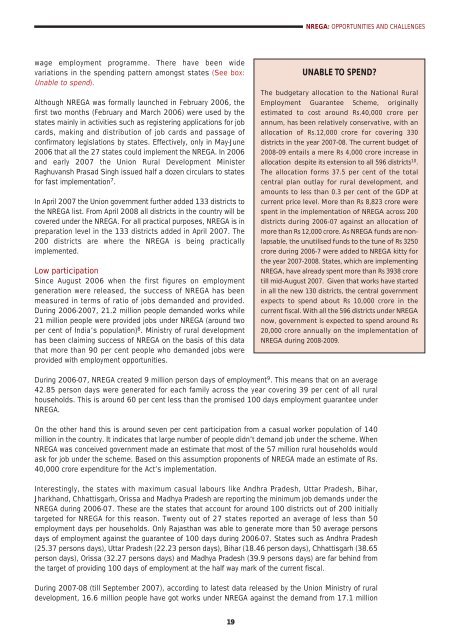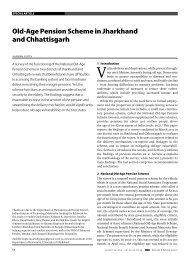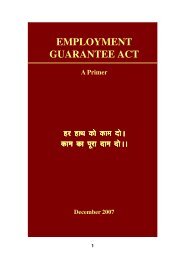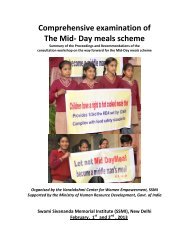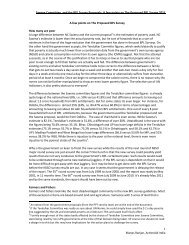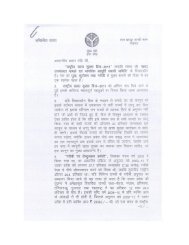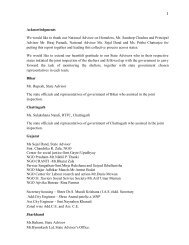NREGA: Opportunities and Challenges - Diksha
NREGA: Opportunities and Challenges - Diksha
NREGA: Opportunities and Challenges - Diksha
Create successful ePaper yourself
Turn your PDF publications into a flip-book with our unique Google optimized e-Paper software.
<strong>NREGA</strong>: OPPORTUNITIES AND CHALLENGESwage employment programme. There have been widevariations in the spending pattern amongst states (See box:Unable to spend).Although <strong>NREGA</strong> was formally launched in February 2006, thefirst two months (February <strong>and</strong> March 2006) were used by thestates mainly in activities such as registering applications for jobcards, making <strong>and</strong> distribution of job cards <strong>and</strong> passage ofconfirmatory legislations by states. Effectively, only in May-June2006 that all the 27 states could implement the <strong>NREGA</strong>. In 2006<strong>and</strong> early 2007 the Union Rural Development MinisterRaghuvansh Prasad Singh issued half a dozen circulars to statesfor fast implementation 7 .In April 2007 the Union government further added 133 districts tothe <strong>NREGA</strong> list. From April 2008 all districts in the country will becovered under the <strong>NREGA</strong>. For all practical purposes, <strong>NREGA</strong> is inpreparation level in the 133 districts added in April 2007. The200 districts are where the <strong>NREGA</strong> is being practicallyimplemented.Low participationSince August 2006 when the first figures on employmentgeneration were released, the success of <strong>NREGA</strong> has beenmeasured in terms of ratio of jobs dem<strong>and</strong>ed <strong>and</strong> provided.During 2006-2007, 21.2 million people dem<strong>and</strong>ed works while21 million people were provided jobs under <strong>NREGA</strong> (around twoper cent of India’s population) 8 . Ministry of rural developmenthas been claiming success of <strong>NREGA</strong> on the basis of this datathat more than 90 per cent people who dem<strong>and</strong>ed jobs wereprovided with employment opportunities.UNABLE TO SPEND?The budgetary allocation to the National RuralEmployment Guarantee Scheme, originallyestimated to cost around Rs.40,000 crore perannum, has been relatively conservative, with anallocation of Rs.12,000 crore for covering 330districts in the year 2007-08. The current budget of2008-09 entails a mere Rs 4,000 crore increase inallocation despite its extension to all 596 districts 10 .The allocation forms 37.5 per cent of the totalcentral plan outlay for rural development, <strong>and</strong>amounts to less than 0.3 per cent of the GDP atcurrent price level. More than Rs 8,823 crore werespent in the implementation of <strong>NREGA</strong> across 200districts during 2006-07 against an allocation ofmore than Rs 12,000 crore. As <strong>NREGA</strong> funds are nonlapsable,the unutilised funds to the tune of Rs 3250crore during 2006-7 were added to <strong>NREGA</strong> kitty forthe year 2007-2008. States, which are implementing<strong>NREGA</strong>, have already spent more than Rs 3938 croretill mid-August 2007. Given that works have startedin all the new 130 districts, the central governmentexpects to spend about Rs 10,000 crore in thecurrent fiscal. With all the 596 districts under <strong>NREGA</strong>now, government is expected to spend around Rs20,000 crore annually on the implementation of<strong>NREGA</strong> during 2008-2009.During 2006-07, <strong>NREGA</strong> created 9 million person days of employment 9 . This means that on an average42.85 person days were generated for each family across the year covering 39 per cent of all ruralhouseholds. This is around 60 per cent less than the promised 100 days employment guarantee under<strong>NREGA</strong>.On the other h<strong>and</strong> this is around seven per cent participation from a casual worker population of 140million in the country. It indicates that large number of people didn’t dem<strong>and</strong> job under the scheme. When<strong>NREGA</strong> was conceived government made an estimate that most of the 57 million rural households wouldask for job under the scheme. Based on this assumption proponents of <strong>NREGA</strong> made an estimate of Rs.40,000 crore expenditure for the Act’s implementation.Interestingly, the states with maximum casual labours like Andhra Pradesh, Uttar Pradesh, Bihar,Jharkh<strong>and</strong>, Chhattisgarh, Orissa <strong>and</strong> Madhya Pradesh are reporting the minimum job dem<strong>and</strong>s under the<strong>NREGA</strong> during 2006-07. These are the states that account for around 100 districts out of 200 initiallytargeted for <strong>NREGA</strong> for this reason. Twenty out of 27 states reported an average of less than 50employment days per households. Only Rajasthan was able to generate more than 50 average personsdays of employment against the guarantee of 100 days during 2006-07. States such as Andhra Pradesh(25.37 persons days), Uttar Pradesh (22.23 person days), Bihar (18.46 person days), Chhattisgarh (38.65person days), Orissa (32.27 persons days) <strong>and</strong> Madhya Pradesh (39.9 persons days) are far behind fromthe target of providing 100 days of employment at the half way mark of the current fiscal.During 2007-08 (till September 2007), according to latest data released by the Union Ministry of ruraldevelopment, 16.6 million people have got works under <strong>NREGA</strong> against the dem<strong>and</strong> from 17.1 million19


